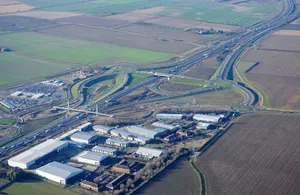
Highways England has announced that the new A14 dual carriageway upgrade in the UK will open in the second quarter of 2020, some six months ahead of schedule. The project has cost £1.5 billion to carry out and is designed to reduce delays for transport between the East of England and the Midlands.
The first 19km bypass section of the new 34km route opened in late 2019, one year ahead of schedule. This important route is vital for the UK’s transport needs and carries around 85,000 vehicles/day, including 21,000 heavy vehicles/day. The A14 connects ports in East England with the West Midlands, a key hub for industry and logistics.
The project has been carried out to reduce congestion and delays through this part of the UK and the new A14 section will improve traffic flow and capacity considerably. The work has been carried out by a joint venture; the A14 Integrated Delivery Team. This comprises Balfour Beatty, Costain and Skanska, and design consultants Atkins and CH2M.
The project has previously won four awards at the 2019 British Construction Industry Awards. The awards were: Digital Transformation Initiative of the Year; Productivity Initiative of the Year; Partnership Initiative of the Year; Initiative of the Year Award.
Construction activity commenced on the project in November 2016, and the work has employed around 13,000 people in all. The new link will operate as an A road trunk route, instead of a motorway as had been originally planned.
As well as the Huntingdon southern bypass, the project includes an upgrade to the A14 between Swavesey and Milton, and a new local access road, the A1307, which runs parallel to it between Cambridge and Godmanchester. In addition, 38km of new facilities for vulnerable road users have also been included in the overall scheme.
The spring opening date will mark the end of permanent roadworks and reduced speed limits on the new A14 and the A1307. However, the project team will still need to carry out landscaping, installing new traffic management technology, and work in the verges. Some temporary overnight closures or off-peak daytime lane closures will be needed.








